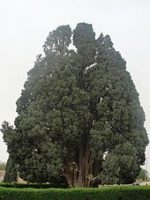 Native to the eastern Mediterranean region including parts of North Africa, Europe, and the Middle East, this evergreen coniferous tree is also known as Italian cypress, Tuscan cypress, Persian cypress, and pencil pine. It is in the cypress family, Cupressaceae that also includes redwoods and junipers. The trees can grow up to 115′ feet tall but usually are 40-60′. The foliage is aromatic when crushed and grows in dense sprays. The dark gray-green leaves are scale-like and grow on rounded shoots. Male and female cones are on the same tree. The ovoid to oblong female cones are less than 1.5″ across and are green ripening to brown 20-24 months after pollination. Photo Credit Wikipedia
Native to the eastern Mediterranean region including parts of North Africa, Europe, and the Middle East, this evergreen coniferous tree is also known as Italian cypress, Tuscan cypress, Persian cypress, and pencil pine. It is in the cypress family, Cupressaceae that also includes redwoods and junipers. The trees can grow up to 115′ feet tall but usually are 40-60′. The foliage is aromatic when crushed and grows in dense sprays. The dark gray-green leaves are scale-like and grow on rounded shoots. Male and female cones are on the same tree. The ovoid to oblong female cones are less than 1.5″ across and are green ripening to brown 20-24 months after pollination. Photo Credit Wikipedia
Mediterranean cypress is widely distrbiuted in the mountains of the Bible lands and in rows with cedar and oak on Mount Lebanon and Mount Hermon. Several Hebrew words are used for tree/s that can be translated in numerous ways including gopher wood (an unidentified tree), acacia boxwood, fir, timber, pine or cypress. The cypress in the following 5 passages is believed by several authorities to be C. sempervirens var. horizontalis.
Genesis 6:14 (NIV) God directs Noah to build an ark.
“So make yourself an ark of cypress wood; make rooms in it and coat it with pitch inside and out.”
Isaiah 41: 19 (NIV) God promises all the people to make even the most barren places into forests.
“I will put in the desert the cedar and the acacia, the myrtle and the olive. I will set junipers in the wasteland, the fir and the cypress together,”
Isaiah 60:13 (NLT) Riches will pour into Israel in the future.
“The glory of Lebanon will be yours— the forests of cypress, fir, and pine— to beautify my sanctuary. My Temple will be glorious!”
Ecclesiasticus 24:13 (NAB) The author discusses the excellence and social characteristics of wisdom.
“‘Like a cedar in Lebanon I grew tall, like a cypress on Mount Hermon;’ ”
Ecclesiasticus 50:10 (GNT) The author praises the great men of the past and their deeds.
“like an olive tree loaded with fruit, like a cypress tree towering into the clouds.”
Mediterranean cypress like full sun and average, medium moist, well-drained soil but tolerates some drought. It is generally healthy but may suffer damage by spider mites and canker. Propagation is by cuttings in winter or seed. Mediterranean cypress has been cultivated as an ornamental since ancient times and is a popular tree in suitable climates of western US especially Southern California. The trees are very long-lived, the oldest being a specimen in Iran that is about 4,000 years old.
The genus name, Cupressus, is the Latin name for the Mediterranean cypress. The specific epithet, sempervirens, is from the Latin words semper meaning always, and virere, meaning to be green, and refers to the foliage.